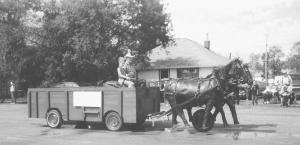2006 - Volume #30, Issue #1, Page #24
[ Sample Stories From This Issue | List of All Stories In This Issue | Print this story
| Read this issue]
Fake Horses Go Up And Down To "Pull" Wagon In Parades
 |
What amused parade-goers is that once they got a close look they could see the horses were fake and the wagon was self-propelled. "Sarah held the lines as if she was driving the horses. To start up, she would slap the horses with the lines and, at the same time, I would step on the accelerator. To stop, she would holler æwhoa', and I would step on the brakes," says Weir, who carries a sign on the wagon that reads "Harvey's Heavy Horses".
The project started innocently enough.
"Last February I got the idea of making two fiberglass horses. After completing them I found some harness, and then I decided I should try driving them," says Weir. "I then made a self-propelled wagon out of a 1975 Datsun station wagon, with the steering wheel and all controls up high on front of the wagon box. I mounted a big caster wheel under the pole that carries the horses. The axle inside the wheel is 3 in. off center, which makes both horses go up and down 6 in. as the wagon pushes them ahead. They look like they're loping along."
He stripped the Datsun down to the wheels, chassis, engine, and automatic transmission, removing the entire frame and the seats. He shortened the frame and driveshaft by 1 ft., then installed a wooden floor on top of it. He removed the wooden box from an old 2-ton truck and bolted it to the chassis.
To make the horses, he made a heavy wire frame and covered it with fiberglass, which he painted black. The manes were made from either cow tails or sisal twine, and the tails from shredded-out plastic twine.
A 15-in. car tire serves as the caster wheel. A 10-in. long axle goes through the wheel, held on either side by metal forks. A metal shaft goes straight up from the forks and through a pipe, which allows the wheel to rotate 360 degrees.
A pole runs lengthwise from the wagon box straight up between the horses, where a wooden neck yoke makes it look like it's holding up the pole.
The drivers sit on a two-part plywood seat and rest their feet on a wooden platform just above the car's engine. A steering wheel is located between the two seats and a V-belt runs from it back to the car's original steering wheel so Weir can steer with one hand down between the seats. A cable runs from an add-on brake pedal around a pulley, to the car's original brake pedal. "When I push down on the brake pedal it pulls on the cable and puts the brakes on. The car's accelerator is also operated by cable. The car came equipped with a floor shift automatic transmission lever. I extended the lever.
"We drove it in seven different parades last summer and it really went over well," says Weir. "Next year I may cover the wagon and add a tape recording of the horses whinnying. Also, I hope to find some businesses that would like to advertise on my unit. It would help with the costs of traveling."
Contact: FARM SHOW Followup, Harvey Weir, P.O. Box 44, Henribourg, Sask., Canada S0J 1C0 (ph 306 764-8343).

Click here to download page story appeared in.

Click here to read entire issue
To read the rest of this story, download this issue below or click here to register with your account number.




